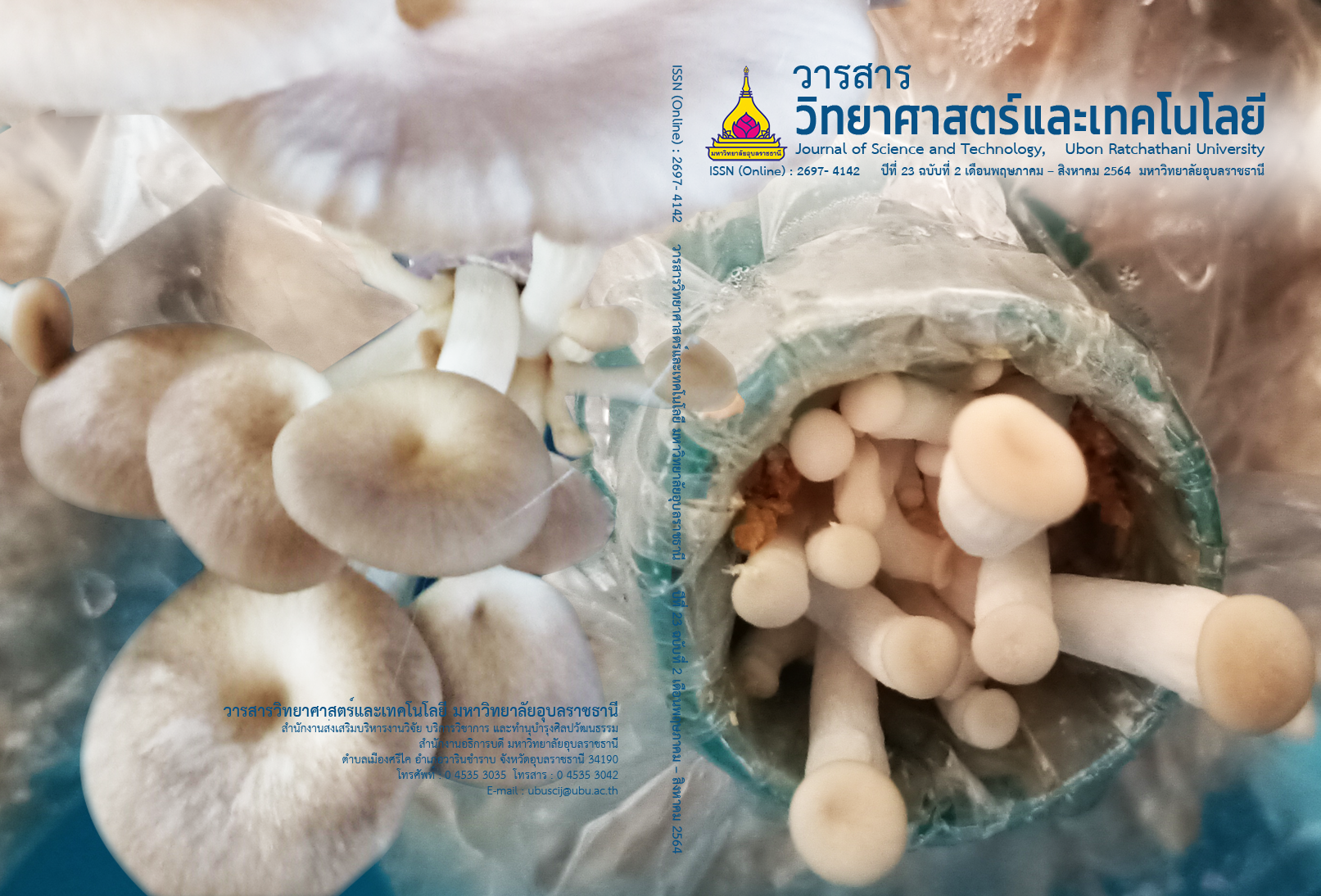การลดต้นทุนการใช้เอนไซม์กลูโคอะไมเลสในกระบวนการผลิตเอทานอลจากมันสำปะหลังด้วยเชื้อยีสต์ Saccharomyces cerevisiae MGT1/1
Main Article Content
บทคัดย่อ
งานวิจัยในครั้งนี้มีวัตถุประสงค์เพื่อศึกษาแนวทางการลดต้นทุนกระบวนการผลิตเอทานอลจากมันสำปะหลังโดยลดปริมาณการใช้เอนไซม์กลูโคอะไมเลสในกระบวนการผลิตด้วยการใช้เชื้อยีสต์ Saccharomyces cerevisiae MGT1/1 ที่สามารถผลิตเอนไซม์กลูโคอะไมเลสซึ่งคัดเลือกได้ในประเทศไทย โดยเป็นเชื้อยีสต์ที่มีคุณสมบัติเหมาะสมในการผลิตเอทานอลจากมันสำปะหลัง ที่สามารถทนอุณหภูมิได้สูงกว่า 35 องศาเซลเซียส ทนต่อความเข้มข้นของเอทานอลได้มากกว่าร้อยละ 15 และทนต่อความเข้มข้นของน้ำตาลได้อย่างน้อยร้อยละ 30 ด้วยวิธีการหมักและย่อยพร้อมกัน (simultaneous saccharification and fermentation; SSF) พบว่าผลิตเอทานอลได้สูงถึง 116.39 กรัมต่อลิตร (ร้อยละ 14.75) และเมื่อลดการใช้เอนไซม์กลูโคอะไมเลสในกระบวนการย่อยลงร้อยละ 25 พบว่ายังคงผลิตเอทานอลได้ 115.69 กรัมต่อลิตร (ร้อยละ 14.66) ในชั่วโมงที่ 48 และสูงถึง 120.54 กรัมต่อลิตร (ร้อยละ 15.20) ในชั่วโมงที่ 72 ซึ่งสามารถลดต้นทุนการใช้เอนไซม์ลงได้อย่างน้อย 1.18 บาทต่อการผลิตเอทานอล 1 ลิตร จากข้อมูลทั้งหมดแสดงให้เห็นว่ายีสต์ที่คัดเลือกจากธรรมชาติสายพันธุ์ S. cerevisiae MGT1/1 มีประสิทธิภาพในการผลิตเอทานอลรวมถึงสามารถที่จะนำไปเป็นแนวทางในการลดต้นทุนกระบวนการผลิตเอทานอลจากมันสำปะหลังในอนาคตได้
Article Details
บทความที่ได้รับการตีพิมพ์เป็นลิขสิทธิ์ของ วารสารวิทยาศาสตร์และเทคโนโลยี มหาวิทยาลัยอุบลราชธานี
ข้อความที่ปรากฏในบทความแต่ละเรื่องในวารสารวิชาการเล่มนี้เป็นความคิดเห็นส่วนตัวของผู้เขียนแต่ละท่านไม่เกี่ยวข้องกับมหาวิทยาลัยอุบลราชธานี และคณาจารย์ท่านอื่นๆในมหาวิทยาลัยฯ แต่อย่างใด ความรับผิดชอบองค์ประกอบทั้งหมดของบทความแต่ละเรื่องเป็นของผู้เขียนแต่ละท่าน หากมีความผิดพลาดใดๆ ผู้เขียนแต่ละท่านจะรับผิดชอบบทความของตนเองแต่ผู้เดียว
เอกสารอ้างอิง
[2] Blieck, L. and et al. 2007. Isolation and characterization of brewer's yeast variants with improved fermentation performance under high-gravity conditions. Applied and environmental microbiology. 73(3), 815–824.
[3] Nguyen, Gheewala and Garivait. (2007). Full Chain Energy Analysis of Fuel Ethanol from Cassava in Thailand. Environmental science and technology. 41, 4135-4142.
[4] Howeler and Reinhardt H. 2008. Cassava in Asia: Designing crop research for competitive markets. In Cassava’s potential in Asia in the 21st Century. Present Situation and Future Research and Development Needs; Proceedings of the 6th Regional Workshop, Ho Chi Minh City, Vietnam, February. 21-25.
[5] Gheewala, N. 2008. Life cycle assessment of fuel ethanol from cassava in Thailand. The International Journal of Life Cycle Assessment. 13.2 (2008), 147-154.
[6] กรมพัฒนาพลังงานทดแทนและอนุรักษ์พลังงาน กระทรวงพลังงาน. โรงงานผลิตเอทานอลเพื่อใช้เป็นเชื้อเพลิงและกำลังการผลิตติดตั้ง. 2020.
https://www.dede.go.th/more_news.php?cid=82&filename=index. (in Thai). Accessed 15 October 2020.
[7] สมาคมการค้าผู้ผลิตเอทานอลไทย. ราคาเอทานอล. 2020.
http://www.thai-ethanol.com/th/statistical-data/price.html. (in Thai) Accessed 21 October 2020.
[8] Auesukaree, C. and et al. 2012. Characterization and gene expression profiles of thermotolerant Saccharomyces cerevisiae isolates from Thai fruits. Journal of Bioscience and Bioengineering. 114(2), 144-9.
[9] Gronchi, N. and et al. 2019. Novel Yeast Strains for the Efficient Saccharification and Fermentation of Starchy By-Products to Bioethanol. Energies. 12, 714.
[10] กรมพัฒนาพลังงานทดแทนและอนุรักษ์พลังงาน กระทรวงพลังงาน. คู่มือการพัฒนาและลงทุนผลิตพลังงานทดแทน ชุดที่ 7 เชื้อเพลิงเอทานอล. 2011. https://www.dede.go.th/article_attach/h_ethanal.pdf. (in Thai). Accessed 20 October 2020.
[11] Janse, B. J. H. and Pretorius, I. S. 1995. One-step enzymatic hydrolysis of starch using a recombinant strain of Saccharomyces cerevisiae producing α-amylase, glucoamylase and pullulanase. Applied Microbiology and Biotechnology. 42, 878–883.
[12] Pugh, T. A. and Clancy M. J. 1990. Differential regulation of STA genes of Saccharomyces cerevisiae.
Molecular Genetics and Genomics. Jun;222(1). 87-96.
[13] Dranginis A. M. (1989). Regulation of STA1 gene expression by MAT during the life cycle of Saccharomyces cerevisiae. Molecular and Cellular Biology. 9(9), 3992–3998.
[14] สมาคมการค้าผู้ผลิตเอทานอลไทย. กระบวนการผลิตเอทานอล. 2013. http://www.thai-ethanol.com/th/2013-04-06-13-53-49/production-process-ethanol.html. (in Thai) Accessed 26 October 2020.


